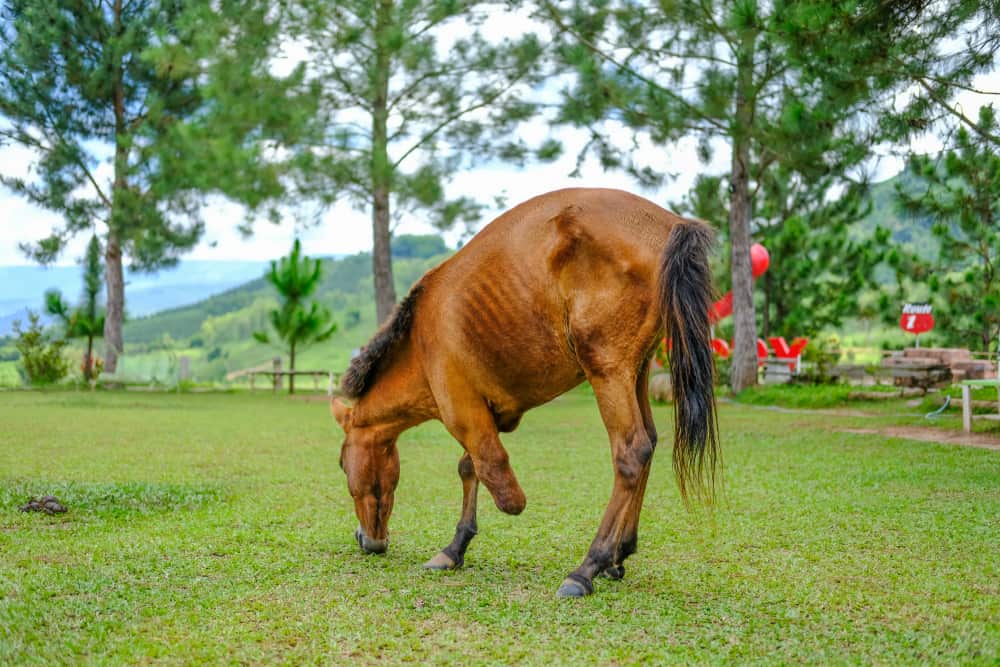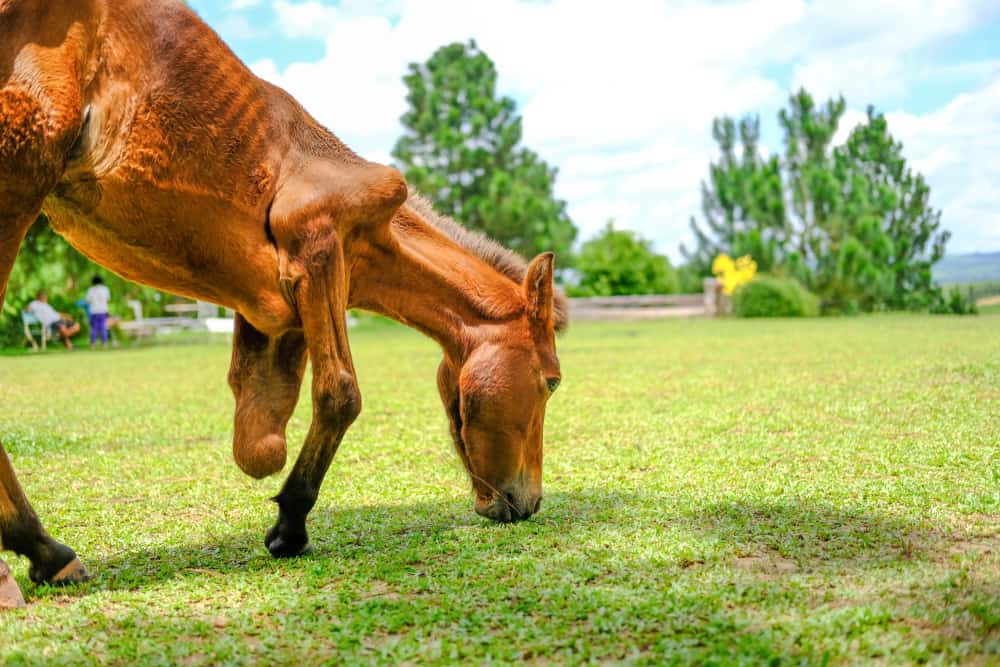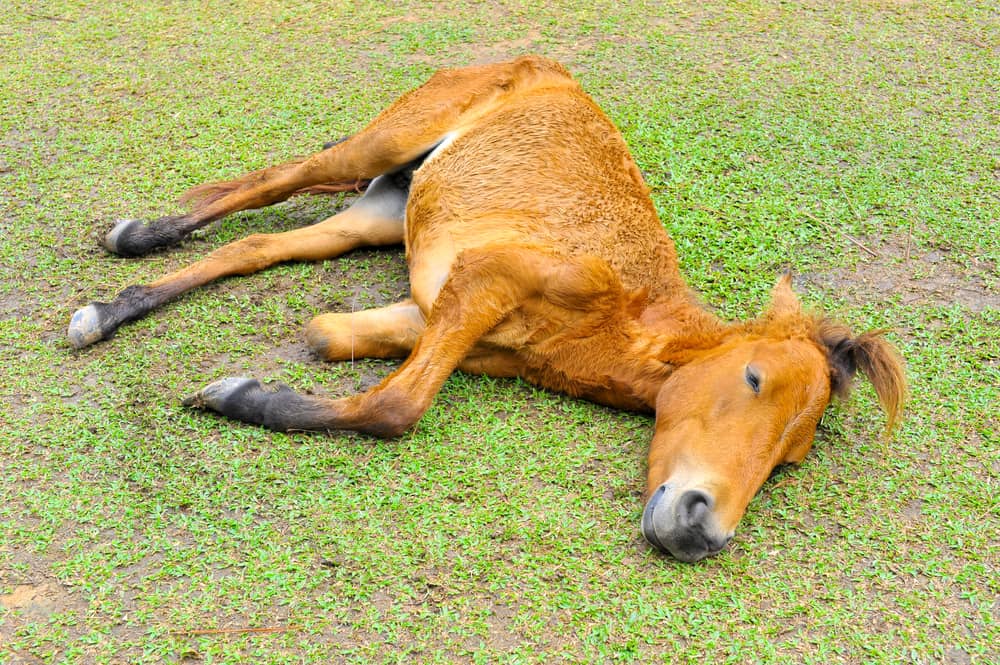Whether you ride your horse daily, race, or compete, it would be most unfortunate for it to break a leg. However, as a loving and caring horse owner, it’s time to understand the practicality of the situation and determine the best way to move forward.
I warn you now that this is a sad topic, but I promise to try to deliver some hope and inspiration to a story that might mean an end to an equestrian dream to many.
Wild Horses vs. Domesticated Horses
If a horse breaks its leg in the wild, it quickly transforms from an agile mammal of elegance to an easy target for other predators in its vicinity.
The reality is that the cycle of life is ever-present whether or not people choose to remain unattached from its earthy connection.
Unfortunately, the prospects of recovery after a domesticated horse has broken its leg is not one of high regard. However, the somewhat promising advantage is that a paddocked horse has the attention of experienced and specialized hands along with a responsible horse owner to help maintain its overall health and wellness.
This article will focus our attention on the possible outcomes for a domesticated horse that has broken its leg. Successful recovery for a horse with a broken leg is significantly lower than for a person with a similar diagnosis.
The entire situation takes on an entirely different set of considerations, primarily because of a horse’s anatomy.
How Bad Is It Doc?
At just four years old, my son suffered a double fracture to his left forearm. The radius bone was broken clear through while the ulna was hanging on by a mere splinter.
After multiple X-rays, the orthopedic recommended an attempt at straightening the bones and lining them up by hand to avoid surgery. By the grace of God, the bone manipulation was a success, and after three weeks in a cast, my son was back to swinging, and climbing, and doing all the things that little monkeys do.
My son’s recovery was successful in part due to his young age and because of the human anatomy. So let us discover more about what I am intending.
Recovery for a three-legged horse will depend on which part of the leg broke, the severity of the fracture, and the horse’s age and overall wellness.
One doctor of veterinary medicine states that a break above the fetlock (or ankle) is more severe and far more challenging to treat. However, a break below the ankle increases the horse’s chances of recovery, but the horse is at risk for further complications.
Incomplete fractures exist when the bone in question has cracked under stress but has not broken entirely. If a horse is diagnosed with an incomplete fracture, its chances of full recovery and return to service are better.
Another situation where a horse may recover fully from a broken leg is when the fracture occurs at a young age. A foal will have a much better shot at recovery than a full-grown horse, mainly because its body is much lighter but also because its bones are still moving and growing.
Why Are Horses Legs Not Meant To Heal?
People do not enjoy talking about weight because numbers have this ugly way of categorizing people into different stigmatized groups. However, in the equestrian world, horse owners must have an open dialogue about their horse’s weight to monitor and maintain its optimal health and performance levels adequately.
In general, a full-grown horse weighs between 900 and 2,000 pounds. “A lean, racing fit Thoroughbred, for example, has an average weight of 900-1,100 pounds, while the average Clydesdale (think Budweiser) weighs in at 1,800-2,000 pounds.”
A horse’s anatomy and behavior patterns are not exactly prime conditions for dealing with a broken bone. A full-grown horse is a large and heavy animal with comparatively slender and quite delicate legs and feet to support it.
Having to support roughly 250 pounds on each leg is not easy by any means. Imagine having to split an additional 250 pounds on three legs that remain in service after a leg fracture.
Sadly enough, the remaining healthy legs can suffer from several additional ailments due to extra weight. And because a horse’s temperament is naturally active, keeping a horse still throughout the recovery process is very difficult.
Although a veterinarian or equestrian orthopedic can prescribe a sling for a recovering horse, this method has some negative characteristics. And although a horse may tolerate a sling for weeks, it is not the usual case; therefore, it is not always a practical long-term option.
A sling may help provide relief to an extra weight-bearing limb, but the
“continued pressure on the hide and skin where the weight-bearing stresses the straps of a sling will likely cause irritation and even lead to sores.”
If the recovering horse does not like the idea of a sling, this may put the horse owner or handler and itself at risk of physical harm. Therefore, long-term sling use is not usually preferable, but the horse must be adequately monitored and medicated throughout the process if all goes well.
Pain management through medication is also a complicated task for an equestrian handler. If a veterinarian administers too little medication, the horse must still bear the pain of the fracture. On the other hand, a horse given a high quantity of pain meds may feel too good and move around in a fashion detrimental to the healing process.
In a world where new scientific advancements continue to improve medical intervention, healthcare costs have become astronomical. Unfortunately, in the equestrian field, not only are there a limited number of expert handlers equipped with the knowledge of treating a horse with a leg fracture, the cost is just too high for many horse owners to afford.
Just like my son, who was playing at the park as if it was any other ordinary day, a horse could potentially risk a broken bone at any time. Unfortunately, the risk is exponentially higher for domesticated horses in the racing and competitive arena due to the increased stress on their bodies.
What Is There To Be Done?
Although there are several success stories about horses that recover from a broken leg, the reality is that most horse owners decide to euthanize their horse to avoid further complications and suffering to the animal.
As a horse owner, you should plan what you will do should some unexpected circumstance befall your horse. Generally, a horse owner will even look ahead to the day that their horse becomes old and cannot comfortably or physically perform essential tasks such as foraging any longer.
An unexpected circumstance such as a broken leg or the eventual possibility of leading a poor quality of life may give a horse owner limited options.
The decision is difficult to make, but horse owners must know all the options available and the procedures involved. According to the Blue Cross, horses typically undergo euthanization by either lethal injection or gunshot.
The decision to euthanize should always be in the animal’s best interest, and the procedure should only be carried out by a qualified professional in the field.
Fortunately, alternatives do exist for treating horses with leg fractures. For instance, Dr. Grant is a highly sought-after surgeon in the equestrian world. So, if your horse has been subject to a horrible fracture but is otherwise healthy, it could be a prosthetic candidate if other healing options are unavailable.
With proper care, a horse with a prosthetic limb can continue to live and prosper with a high quality of life. However, for a procedure such as an amputation to succeed, both the horse and its owner must have a calming and favorable disposition to support the horse’s life-long care adequately.
Another option available is a robotic lift system. Designed by highly specialized field technicians, engineers, and equine radiologists, this device allows the horse mobility while having its weight supported.
Typical slinging methods limit a horse’s regular activity and place weight stress on various parts of the body. Resulting complications include lung compression, bedsores, infection, and laminitis in the horse’s supporting limbs.
The advanced lift system is a novel solution to a problem that affects thousands of racehorses and horse owners every year. But this is not the only innovation that seeks to decrease the euthanization statistics within the equine world of athletes.
Over fifty years ago, the New Bolton Center, an annex of the University of Pennsylvania, innovated a recovery pool system that provides the horse with even the most critical fractures a much better fighting chance at returning to full service with no further complications down the road.
So you see, if your horse has broken its leg, you should feel empowered by the various treatment and healing opportunities now available for your equine life companion.
Conclusion
Although a broken leg can present an uncertain and unfavorable situation for a horse and its owner, there is hope that the horse can live a complete and good quality life.
A horse’s life is a life worth keeping, so if we have decided to domesticate these animals, I believe it is our responsibility to provide the best care possible.
Please feel free to share your questions, concerns, or experiences about the treatment and recovery of a horse that suffers a broken leg in the comment section below.











